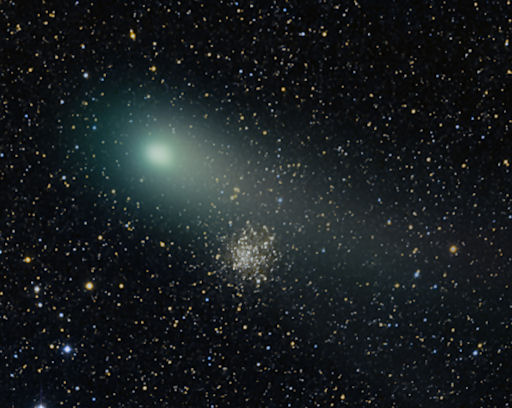Turn your cell phone into a field-tested satellite tracker. Works for Android and iPhone. | | |
SOLAR EXPLOSION: This morning at 0430 UT, the magnetic canopy of departing sunspot 1271 erupted, producing a B5-class solar flare and hurling a CME into space. The beautiful blast was not Earth-directed and will not affect our planet.
more images: from SDO in Earth orbit; from Stratos Tsanaktsidis of Thessaloniki, Greece
COMET GARRADD MEETS M71: This weekend, amateur astronomers around the world are watching the green tail of Comet Garradd (C/2009 P1) sweep across golden star cluster M71. Nick Howes sends this picture of the encounter from Cherhill in Wiltshire UK:

In New Hampshire, Tim Printy photographed the pair "just before the weather in New England turned sour due to the approaching hurricane," he says. "In binoculars, they looked like twin fuzzy patches."
Discovered two years ago by Gordon Garradd in Australia, the 8th-magnitude comet is currently visible through small telescopes in the constellation Sagitta inside the evening Summer Triangle (finder charts). The comet is approaching the sun and brightening; recent projections place it at peak magnitude 6 in February 2012, just at the limit of naked eye visibility. Because Comet Garradd is a first-time visitor to the inner solar system, however, it could behave in unexpected ways. Stay tuned for surprises. [3D orbit] [Comet Hunter Telescope]
more images: from Marek Harman of Vartovka observatory, Banská Bystrica, Slovakia; from Karl Beck of Observatory Michelbach, Austria; from Jimmy Westlake of Stagecoach, Colorado; from Marian Urbaník of Čadca, Slovak republic; from Becky Ramotowski of Tijeras, New Mexico; from Csaba Hadhazi of Hajduhadhaz, Hungary; from Andrew Mccrea of Bangor, Northern Ireland; from Bob Runyan of AstroAsylum BYO, Shelton, NE, USA
RED SPRITES: High above Earth in the realm of meteors and noctilucent clouds, a strange and beautiful form of lightning dances at the edge of space. Researchers call the bolts "sprites"; they are red, fleeting, and tend to come in bunches. Martin Popek of Nýdek in the Czech republic photographed these specimens on August 27th:

"Sprites are a true space weather phenomenon," explains lightning scientist Oscar van der Velde of Sant Vicenç de Castellet, Spain. "They develop in mid-air around 80 km altitude, growing in both directions, first down, then up. This happens when a fierce lightning bolt draws lots of charge from a cloud near Earth's surface. Electric fields [shoot] to the top of Earth's atmosphere--and the result is a sprite. The entire process takes about 20 milliseconds."
Although sprites have been seen for at least a century, most scientists did not believe they existed until after 1989 when sprites were photographed by cameras onboard the space shuttle. Now "sprite chasers" routinely photograph sprites from their own homes. "I used up a Watec 902H2 Ultimate security camera with UFOCapture software to catch my sprites," says Popek. Give it a try!
diagram: How to Look for Sprites (used with permission of sky-fire.tv)
UPDATED: August 2011 Aurora Gallery
[previous Augusts: 2010, 2009, 2008, 2007, 2006, 2005, 2004, 2003, 2002]

